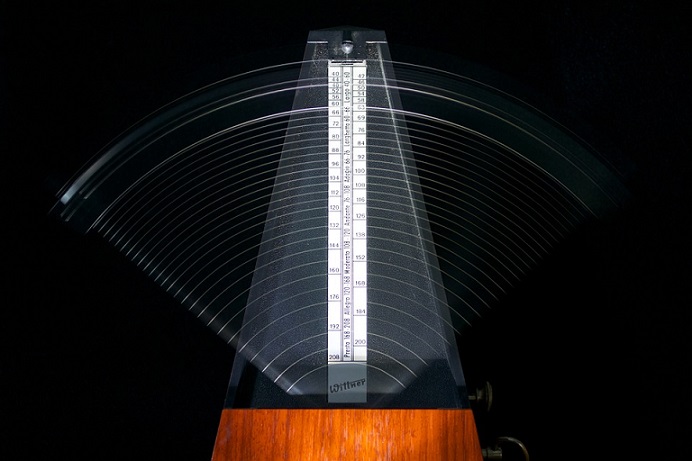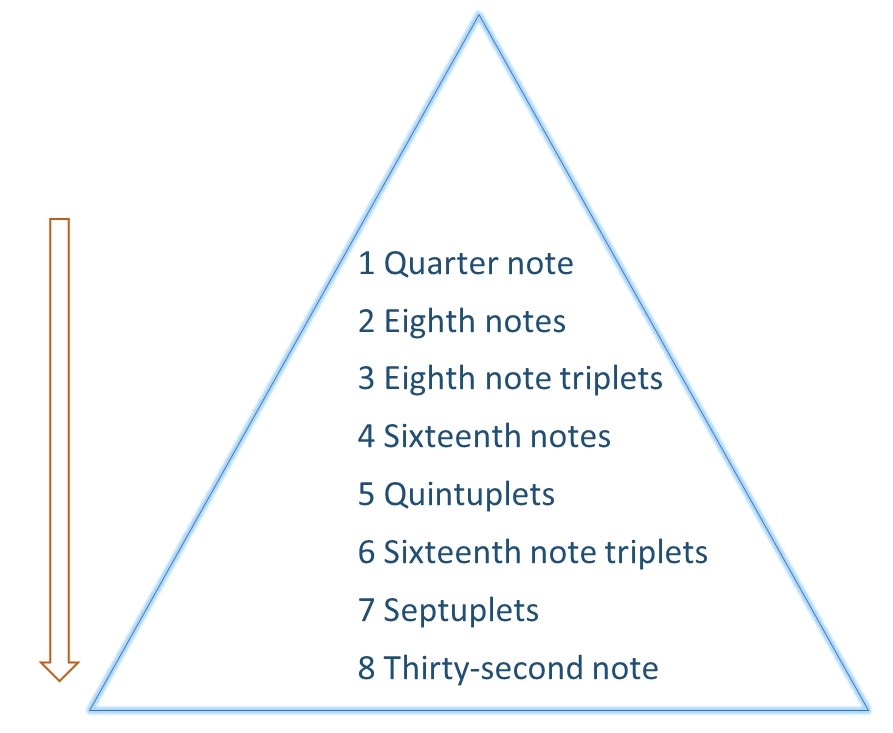
In my previous post I introduced you to the Metronome and shared a technique that I call ‘metronome reduction'.
Metronome Displacement
In many ways Metronome Displacement is similar to Metronome Reduction. You’ll be playing at a moderate or even fast tempo while the metronome is set to an extremely slow tempo. The metronome will be your guide, informing you whether or not you’re in time. I highly recommend starting this exercise after step 6 of Metronome Reduction (a click on beat 1 of every bar), that way you will have had enough time to internalise your starting tempo. The key here is that once your metronome is set, you will not need to change it at all; what changes is where you perceive the click in your bar.
- Decide on an exercise, groove, pattern, etc. and a starting tempo. Make sure that you can divide it by 4 and make a whole number. For example 110 beats per minute won’t work as dividing it by 4 leaves 27.5. If this is the rough tempo you want to try then go for 108 (27) or 112 (28) instead.
- Divide your starting tempo by 4 and set the metronome appropriately. Start playing your exercise so that you’re hearing a click on beat 1 of each bar (step 6 from Metronome Reduction).
- Here is the tricky part. You’re now going to displace the metronome so you hear the click on beat 2 of your bar rather than beat 1. You don’t need to adjust your metronome, just stop playing and start counting. Try to count from 2 instead of 1 to get yourself started, then start playing your exercise again.
- Repeat until you’re completely comfortable hearing the metronome as beat 2, not beat 1.
- Repeat this process so the metronome now clicks on beat 3 of each bar.
- Now repeat so you hear the click on beat 4.
- Once you’re comfortable playing all of the above steps, it’s time to syncopate the metronome. Go through the whole process again but with the metronome playing all 4 offbeat 8th notes in the bar.
Both Metronome Reduction and Metronome Displacement are demonstrated brilliantly by the great bass player Victor Wooten in a video he did for Korg in 2009. Please do check this video out as it will really help you understand these two amazing exercises.
Metronome Displacement is a real challenge and a great way to simulate an ensemble experience. Remember that when playing with other people, not everyone will be playing exactly the same rhythm as you, and you need to keep a steady pulse regardless of whatever else is happening in the music.
The above example only works when playing in 4/4, but the exercise can be adapted to accommodate different time signatures. For example, if you want to play in ¾, divide your starting tempo by 3 (rather than 4) to hear your click on beat 1.
Rhythm Pyramid
This is a really simple exercise that’s great for improving your accuracy when playing different note values. It can be done at any tempo but is far more challenging at lower speeds. I’d recommend trying this at around 80 beats per minute to start, but aim to decrease and increase the metronome incrementally to cover a wide range of tempos.
1. Set your metronome to a moderate tempo.
2. Begin by playing any single note exactly in time with the click. Don’t just wait for the metronome to sound and play soon after, try internalising the tempo even if that means subdividing the beat in your head.

3. Now subdivide the beat in 2 so you’re now playing 8th
4. When comfortable with 8th notes, subdivide the beat in 3 so you’re playing 8th note triplets.
5. Go up like this all the way to 8 notes per beat, 32nd Now go back down.
What you play in this exercise is rhythmically restricted as you have to stick with a particular subdivision of the beat. You can try playing scales or rudiments and this will help you to play all your note values with accuracy. When you’ve become more comfortable with this exercise, try doing each subdivision for a predetermined number of beats. The less time you spend on each subdivision the harder this exercise becomes, so maybe work your way down from 16 beats, to 12 beats, to 8 beats, to 4 beats, to 2 beats and then finish off just playing each subdivision for 1 single beat.
Conclusion
Metronome Reduction, Metronome Displacement, and Rhythm Pyramid are just a small selection of metronome exercises, and each one can be adapted and expanded to accommodate all musicians, regardless of proficiency. Feel free to take each exercise as far as you like and create some of your own.
Remember that the metronome should be incorporated into your regular practice routine. You can practice pretty much anything that’s in time with a metronome and I would highly recommend doing so regularly. You’ll be practising whatever music you’re working on and also improving your time, pulse, and rhythm. In other words, kill two birds with one stone.
Next time we will explore the concept of groove, what it means, how it affects music, and how we can improve our own groove. This is part 5 of our article series: Making the Most of Your Practice. Check out the other articles on
⇒ Part 1: Making Practice Enjoyable
⇒ Part 2: Setting Practice Goals
⇒ Part 3: Practice Planning
⇒ Part 4: The Metronome
Learn music with us. First month is free.
30-Day Free Trial. Cancel Anytime.
About Liberty Park Music
LPM is an online music school. We teach a variety of instruments and styles, including classical and jazz guitar, piano, drums, and music theory. We offer high-quality music lessons designed by accredited teachers from around the world. Our growing database of over 350 lessons come with many features—self-assessments, live chats, quizzes etc. Learn music with LPM, anytime, anywhere!










